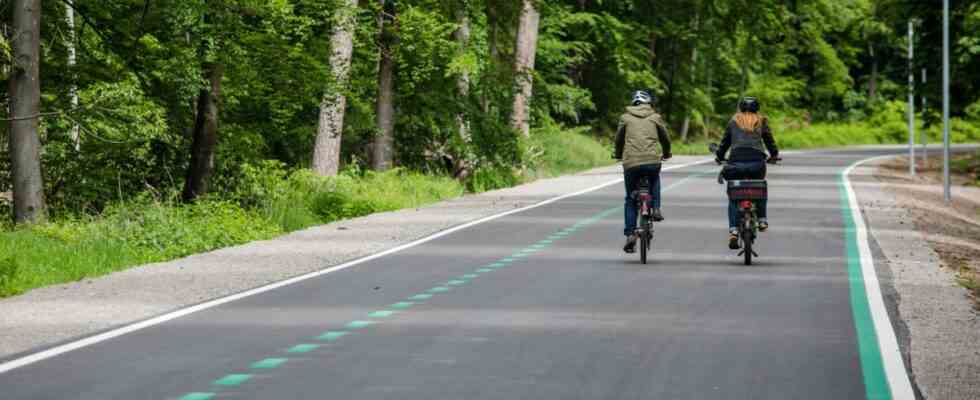On the last few meters just before the Autostadt Stuttgart, you cross a bridge over the A8. Below, cars and trucks rush through eight lanes, the noise of the traffic booms upwards. To a certain extent, the past and future of transport policy meet directly on the outskirts of Stuttgart, in front of the district of Vaihingen: Baden-Württemberg’s first express cycle route hovers above the autobahn from Böblingen to Stuttgart, an eight-kilometre-long route that has attracted many people to it for three years to leave the car at home or to switch to the bike altogether. What works in Baden-Württemberg should now finally be implemented in the Munich area – after more than seven years of planning.
In the not too distant future, commuters should be able to cycle comfortably and safely over a total distance of 23 kilometers from Munich’s Stachus to Garching and Unterschleißheim. In Munich, work began a few weeks ago on the first, approximately 500-meter-long section from Lenbachplatz to the square of the victims of National Socialism. The first fragment, around 2.8 kilometers long, is to be erected in Garching next year outside of the state capital.
“I can’t and don’t want to name a time period,” says the planner
When the complete Radschnellweg will be completed is still written in the stars. “I can’t and don’t want to name a period,” says Tanja Sartorius, who is responsible for the federal, state and district roads in the Munich district at the Freising State Building Authority. And with that she explicitly does not refer to the route in the Garching urban area, because the district itself is responsible for the construction there State building authority responsible.
In Garching, cyclists should be able to switch quickly from the bike to the subway and vice versa.
(Photo: Sonja Marzoner)
And that makes things a bit more complicated, respectively the fact that the cycle expressway is being built directly on a federal highway. The route from Böblingen to Stuttgart, for example, runs almost exclusively through a forest area, which has significantly simplified the planning times. “Since we are here in the district of Munich on a federal highway, a planning approval procedure is necessary,” explains Sartorius – and the duration of such a procedure can hardly be estimated. “Because this is also the first cycle expressway that we are planning,” says the employee in the state building authority.
Things are now a bit easier in the Garching city area, although in the recent past there has been a lot of fighting about the right route, especially in the university town, because space there is cramped. The solution that has now been developed has ultimately convinced the city council, although it is associated with some tricky peculiarities. For example, three new, large engineering structures have to be built exclusively for bicycle traffic. And this effort, according to the Munich district office, also prevents the 7.1-kilometer route within Garching from being built in one go.
Therefore, starting next year, the section from the intersection of the B 471 and the B 13 on the south-western edge of Garching-Hochbrück in an easterly direction along the Schleissheim Canal, from there northwards in the direction of the Hochbrück underground station and finally to the car park, will be implemented first on Daimlerstraße, where the cycle expressway connects to the existing footpaths and cycle paths. The construction costs for this section alone are estimated at around 3.6 million euros. From 2024 onwards, the other sections are to be tackled in order to also connect the Technical University in the north of the city.
Objections from those affected can slow down the approval process
The district of Munich is realizing the route in Garching itself in a so-called special construction contract. In addition, the route largely runs on land that belongs to the city itself; the acquisition of privately owned land was “largely completed”, according to the district office. All this helps to speed up the project, at least within the university town.
For the section from the border to the state capital to the intersection of the two federal roads, however, the planning approval process will not be initiated until next year. And this can certainly contain some pitfalls. Because as soon as the plan approval procedure has been received by the government of Upper Bavaria, those affected can submit objections. And it is not at all foreseeable how many there will be, explains Sartorius from the road construction authority. “And it does make a difference whether there are 1,000 or 10,000,” she says – which is why it is dubious to name a period. Perhaps, according to Sartorius, the image of a “green project” means that there are fewer concerns, but the envisaged width of six meters, which characterizes a cycle expressway, could also lead to more objections being raised.
A preliminary design is currently being drawn up by the state building authority for the section from the intersection of the two federal roads to Unterschleißheim. The main issue here is where exactly the route should run. Flora and fauna must also be taken into account, says Sartorius. “We have to see what lives there and wait for the results of the mapping,” says the planner. “And we also have very cramped conditions here, which must be taken into account.”
So it may be a while before – as politicians hope – thousands of commuters will be traveling on Bavaria’s first cycle expressway every day. But it should then become a successful model like the one from Böblingen to Stuttgart. A counting station there recorded well over half a million commuters after just under a year and a half. The members of the construction committee of the district council, which will deal with the project this Thursday and get the first, small section in Garching on its way, are also counting on this.

